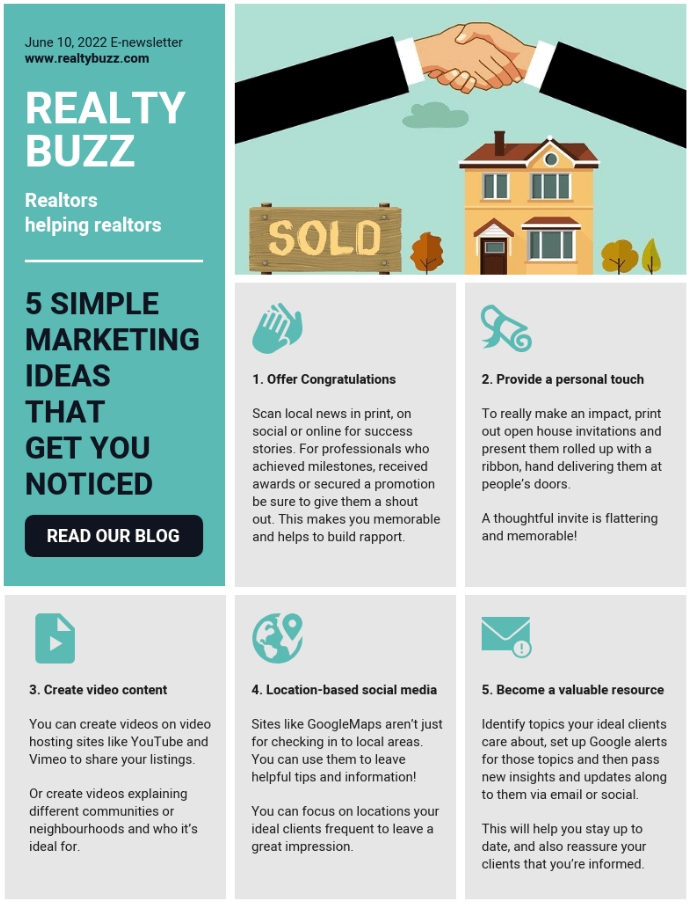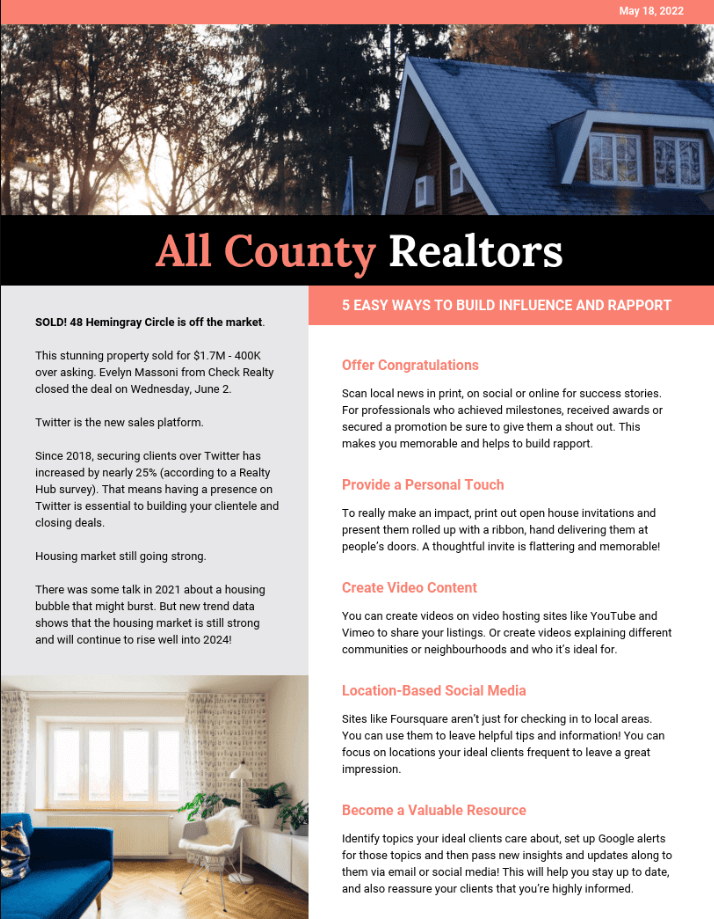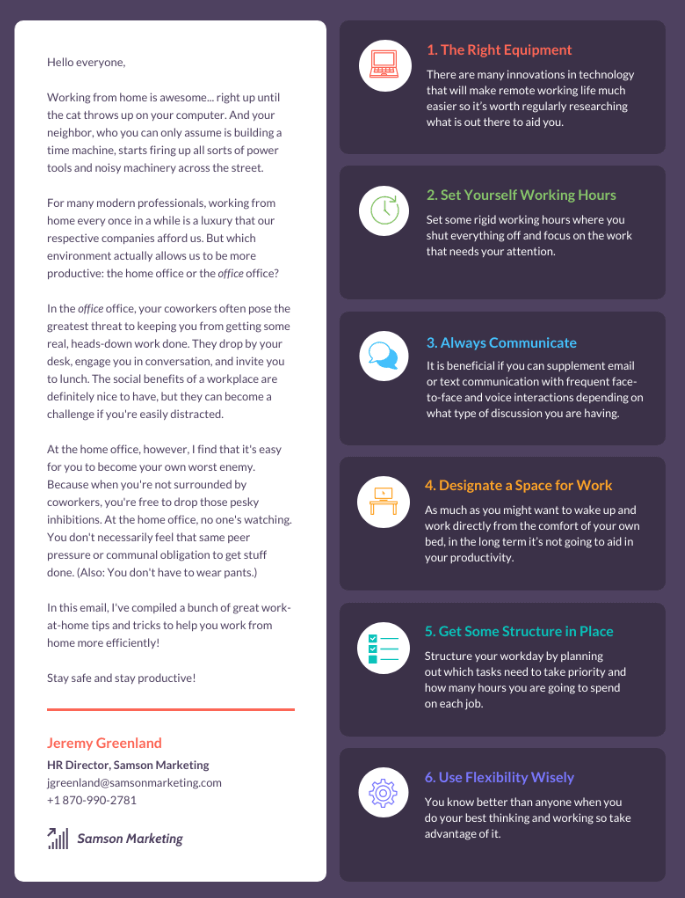What’s the secret to a healthy and vibrant company? Believe it or not, but a company newsletter plays a key factor in success.
Companies that keep employees and customers informed with newsletters are able to retain their staff and grow.
But how a business communicates is important. Since most companies only have a few seconds to convince people to listen, this is where a visual medium like a newsletter really shines.
In this post, I’ll explain what newsletters are, share design tips, and then show some examples of newsletter templates you can use.
Click to jump ahead:
- What are newsletters?
- How to create a newsletter
- Best practices to create an engaging newsletter
- Newsletter ideas for any business
What is a company newsletter?
Newsletters are a form of content that features information such as news, tips, and updates about a product or business.
The distribution channel for newsletters is email, but there are ways as well like print and other digital channels.
For example, a company may use newsletters to inform employees about Breast Cancer Awareness Month.
But a company newsletter can also be sent to people outside the company.
For example, a business can send newsletters to customers with offers or early access to a collection.
Thus, a newsletter builds relationships no matter who it is sent to.
Newsletters can vary depending on your needs, but a few examples include repurposed blog posts, event invitations, promotional messages, and discounts.
Any type of business can use newsletters, such as the corporate sector, non-profits, educational institutions, and even the government.
In the example above, a single school newsletter is able to welcome students back and also share a schedule of upcoming events.
Depending on your needs, newsletters can be hyper-focused or have a broader scope.
How to create a newsletter like a pro
Now, I’ll show you how to design a newsletter that looks good.
Here is what you need to do:
- Define your goals
First, figure out what your goal is. For example, do you want to share news about company events, highlight messages, or promote new products to customers?
Your answer to this question will define the content and design of a newsletter.
- Understand the audience
Start by segmenting your audience into different categories.
A few ways you can do this is to use age, role, gender, or occupation to create personalized newsletters that serve targeted needs.
- Create your newsletter
Now, it’s time to bring your ideas to life.
Worried about your lack of design skills? Well, there’s good news since you don’t need to be the next Picasso to create stunning newsletters.
Simply head to Venngage’s Newsletter Creator to get started.
On Venngage, you’ll find customizable newsletter templates that you can make your own in a few seconds using a drag-and-drop editor.
Most templates are free to use but some may require a monthly fee. However, you can sign up without making any payment.
Venngage allows you to replace text, images and even change the color scheme of the template to match your brand.
Here’s an overview of what to expect in Venngage’s Newsletter Creator:
- Visualization options
- Free stock images and illustrations
- Unique icons
- Easy branding with My Brand Kit (paid plan)
Besides helping reduce workload, Venngage allows creators to focus on their message rather than worry about design.
- Publish consistently
Consistency is key to making effective a company newsletter.
Create a schedule for your newsletters and schedule their release at the same time each week or month.
For example, if you have a quarterly newsletter, send it every three months.
Best design practices for a company newsletter
It’s not uncommon for companies to have one or multiple newsletters, and this can make it difficult to get eyes on your newsletter.
You need a way to get people to open your newsletter. However, you need to do so in a way that doesn’t get your email deleted.
- Don’t overlook the subject line
Email is still the most popular distribution channel.
And the first thing people see when they get an email is the subject line, and it does influence whether people open or delete an email.
So, spend time optimizing the subject line of your company newsletter to grab the attention of your target audience.
- Follow the KISS principle
The human brain processes visual information faster than text. This is why visual newsletters are so effective.
So avoid using too much text in a company newsletter.
This isn’t a golden rule though as you can large blocks of text to accompany informative headlines.
Here’s an example of a real estate company that does a great job repurposing a blog post as a newsletter.
- Use catchy headlines and subheadings
Headlines play an important role in drawing readers in, so pay extra attention here.
Here are a few ways to make your headlines stand out:
- Include numbers
- Create urgency
- Pique curiosity
Here’s an external newsletter that does a great job at this:
The headline is friendly and asks readers for a favor.
It then rewards those who help with a special discount. This is a great way to collect feedback while building brand loyalty.
- Inject personality
A company newsletter should distinguish your brand.
Using formal language is a recipe for failure since a newsletter is far more effective if you sound human.
Showcase some personality that makes a competitor can’t copy such as the use of humor, funny images, and silly jokes that add to your unique ‘personality.’
- Design for scannability
Like most content, readers skim newsletters.
That’s why you have to make your newsletter scannable, and one way to do that is to use layout to your advantage.
Visual cues and color contrast are great ways to draw readers’ attention where you want it.
For example, here’s a newsletter that uses color contrast in headlines.
Examples of the different types of newsletters
Need some ideas or inspiration for your company newsletter?
In this section, I’ll share some examples and templates so you can start creating right away.
But first, a word of caution. Newsletters should not feature outdated information, since people want the latest information.
Newsletters can help achieve a variety of objectives such as company announcements and updates about office policies.
Here are a few company newsletter ideas to get you started:
- New product announcements
- Milestones achieved
- New employee announcements
- Updates on upcoming company events
- Improvements in metrics
And here are some newsletters you can send to customers:
- Round-up of blog posts
- Membership/customer deals
- Behind-the-scenes look at the company
- Spotlight of photos and stories shared by customers
Let’s look at some newsletter template examples:
- Announcements
Often, a newsletter is the best way to share information with employee.
For example, a company-wide announcement newsletter can let employees know about holidays, office parties, or even remind them of birthdays.
- Round-ups
Round-up newsletters often appear as listicles since this format is a great way to make information easy to remember.
- Customer deals
Want to reward loyalty or stay on the mind of your customers?
Well, newsletters are a great way of creating a sense of exclusivity since it lets you share information only with a select few.
- Introducing staff
Announcing new hires with a newsletter is a great way to start relationships.
It’s also a clever way to get your staff to learn more about new teammates before any ice-breaker activities.
Over to you
Creating a company newsletter from scratch can be a daunting process since there are many factors to consider such as content, design, and overall flow.
Fortunately, newsletter builders help you save time on design, so you can focus energy on crafting a story that achieves your desired goals.



















































